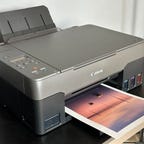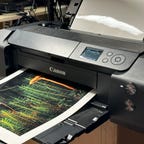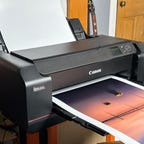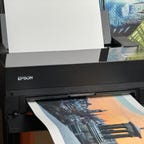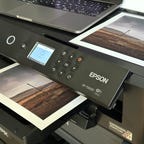Best Photo Printer of 2024: Canon, Epson, Instax Compared
Whether you're a pro photographer or you just want some colorful prints to send to family, there's a printer to suit.
Our Picks
Today's best cameras -- and phones, of course -- make it incredibly easy to capture beautiful images. But all too often those images sit on our hard drives or in cloud storage for years, some never to be seen again or shared. Printing out pictures isn't just a great way to make it easy to display them around the house, it can also be the first step in selling your artwork online, at fairs or in galleries.
Though most home color printers can quickly knock out a decent-looking photo print, dedicated photo printers like the ones on this list offer better quality prints, with richer, more accurate colors and sharper details.
Read more: Best Camera to Buy in 2024
I've rounded up the best printers you can buy right now to start creating your own photo prints at home. Every item on this list has been tested with numerous prints at the maximum available size, with original inks and on both manufacturer-supplied paper and specialist fine art hemp photo paper from Hahnemuehle.
Canon's G3260 (tested in the UK as the G3250, but it's essentially identical) is a solid all-round option for people who want a multipurpose office printer that also handles image printing. It's got a built-in scanner and can print photos up to A4 in size (A4 is about 8.5 by 11 inches). It has large, refillable tanks, rather than cartridges, which apart from saving on plastic, also allows it to boast "up to" 7,700 color prints from a full set of inks.
In my tests, I found it to be easy to set up and get printing using Canon's software. Print quality is good, with vibrant colors and sufficient detail for most users. It even comes with pretty much a full set of inks, making the initial outlay a lot more reasonable, as it'll be some time before you need to splash out on new ink. Canon has discontinued the G3260 and replaced it with the G3270. Though the updated model has a nicer design, we still feel the G3260 is the better photo printer of the two and is worth hunting down if possible.
Canon ImagePROGRAF Pro-300
Canon's Pro-300 is a big step up from the G3560, but we're entering professional photo printer territory and you get what pay for when it comes to image quality. The Pro-300 is a chunky machine, but it can print up to A3 Plus in size (A3 Plus is 13 by 19 inches). It uses 10 individual ink cartridges to allow for greater accuracy in color reproduction.
The inks themselves are Canon's pigment-based Lucia Pro inks, which are designed to offer deeper colors, better reproduction and consistent outputs. Canon also boasts that these inks are more fade resistant, so your prints will look better for longer.
I found the setup of the Pro-300 to be fairly straightforward, and printing through Canon's printing layout software was mostly hassle-free. The printer has Wi-Fi connectivity, but I found connecting over USB was by far the easier method. I had some trouble getting accurate colors printing via Adobe Lightroom with ICC color profiles for my Hahnemuehle paper, but after a few test prints and tweaking of the settings I had prints coming out as expected.
The step-up in quality over the cheaper model is noticeable, with pin-sharp details and rich colors that looked great on both Canon's glossy photo paper and the matte texture of the Hahnemuehle paper. If you're looking to take your first steps into printing for display or to sell on Etsy, the Pro-300 is a solid option to consider.
Canon imagePROGRAF Pro-1000
As the top model in Canon's prosumer imagePROGRAF printer line, it's no surprise that the Pro-1000 comes with the highest price tag attached. What did take me back a bit though is how massive it is. It's a hulking beast, measuring almost 29 inches wide and weighing more than 32 kilos (70.5 pounds). In short, make sure you've got a big space in your home office set aside to accommodate it.
But it's big for a reason. Chiefly, its ability to print images up to A2 in size, making it great for those of you wanting to display your images in large format sizes, especially as it can handle heavyweight paper up to 300 gsm. (A2 converts to roughly 17 by 23 inches; the Pro-1000 lists 17 by 22 inches among its paper sizes.) It uses 12 pigment-based Lucia Pro inks, offering even greater color accuracy than the cheaper Pro-300. And it shows, as this printer is able to produce absolutely pristine images, with superb details and spot-on colors.
But it's a professional machine, and as such it isn't always especially user friendly. It's slow to turn on, and I had to do multiple test prints, adjusting settings for each new image I wanted to print before being happy with the result.
That kind of fine-tuning is par for the course for a pro printer, especially if you're a photographer wanting to sell prints. But it's important to remember that each test print uses up precious ink and paper, and a full set of ink for the Pro-1000 costs $640. The printer will also need to perform various nozzle checks and other maintenance tasks, which usually involves using some ink as well. While it's almost impossible to say how many prints you'd get from a full set of inks, some reports online suggest you can expect up to about 200 A2 prints per set.
You can rest assured, though, that those prints will look superb and will certainly suit professionals looking to sell their work as prints. Just make sure you're selling your prints at a higher cost to justify the amount you're spending to make them.
Epson SureColor SC-P900
The P900 is Epson's answer to Canon's Pro-1000, offering A2-size photo prints at display quality. Physically, I prefer Epson's machine. It's much smaller and much lighter, and it's got a sleeker look. Do the aesthetics of a printer matter? No, not really. But if it's going to sit in your office on display for years, then it certainly doesn't hurt to have more of a nod toward design.
It uses 10 separate ink cartridges, including different channels for matte black and photo black, which are designed to give better depth and contrast for both color and black-and-white prints. And certainly, I found the color reproduction to be superb on the P900, with rich tones and satisfying contrast on my test prints and fine-art prints.
As with Canon's pro printers, getting the right colors when starting each print run was a bit fiddly, and after trying and failing with Lightroom and paper profiles, I actually found that using auto settings in Epson's own print software gave me the best looking results in printing my own photography. That's fine by me, why overcomplicate things?
A set of 10 inks costs $440, which is less than the Pro-1000, but you can expect to replace them fairly frequently, especially if printing at A2 sizes. Frustratingly, I found that the printer would often show a warning about low ink levels and recommend replacing the tank but then would still go on to produce multiple A2 prints. Other small criticisms include a flimsy paper tray, which I managed to break with almost no effort, and a roller that more often than not failed to grip onto and feed through thicker paper (290 gsm) despite this paper weight being supported by the printer.
So no, the Epson isn't a perfect printer, but its overall size and print quality make it my personal choice for larger-size professional photo prints.
Epson Expression Photo HD XP-15000
With a more affordable $300 asking price, but with print sizes available up to A3 Plus (or 13 by 19 inches), Epson's XP-15000 is a solid option for those of you wanting to experiment with larger photo prints without investing too much up front. It uses the same six Claria inks as the more expensive EcoTank model listed below, albeit in a smaller cartridge format that'll offer a much lower print yield as a result (hence the price difference).
But it still offers great image quality, with vibrant colors and satisfying gradation between tones. I found it particularly easy to print with too, with Epson's print software quickly delivering results that I'd be happy to send to family and friends. Is its quality as good as Epson's P900? No, and that's why it's much cheaper, but you'd have to really get up close to notice much difference, and it's hopefully unlikely any of your friends are going to be studying your print quality with a loupe and then complaining at you. If they do, maybe drop them as friends rather than worry about your printer.
I particularly like that the XP-15000 prints quickly and can hold many sheets of decent weight paper in its hopper, allowing you to turn around bigger print runs without much hassle. Those of you looking to start selling prints of photos or illustrations on Etsy would be well served by the XP-15000.
Epson EcoTank ET-8550
The model I tested is actually the Epson EcoTank ET-18100, which isn't sold in the US. And while the 8550 has additional features, like a color touch display, the fundamental elements of the six-tank printing and A3 Plus (or 13 by 19 inch) format remains the same. They aren't quite perfect equivalents, but they're close enough, including in price, so I'm confident in recommending the ET-8550 to those of you in the US and the ET-18100 to people in the UK. What follows is my experience with the ET-18100.
As part of Epson's EcoTank range, the ET-18100 is all about maximizing volume in its printing while keeping ink costs down. It uses six ink containers, which can be refilled individually with bottles, rather than replacing entire cartridges. Epson reckons you can get up to 2,100 4x6-inch color prints from a full set of inks, which is an impressive figure.
Not having 2,100 sheets of photo paper to waste, I didn't try to get anywhere close to that figure, but I also didn't notice any shift in ink levels from all of my testing, so I'm confident the ET-18100 offers good ink efficiency here.
Print quality is good too. I was impressed by the overall color and clarity of each print, with rich colors and excellent accuracy.
Fujifilm Instax Square Link, Wide Link
The Instax name is perhaps better known for the line of instant cameras that churn out prints in seconds to delight your friends at the party, but you can get the same instant-print technology in a standalone printer format too. Both the Square Link and Wide Link (which, as the names suggest, offer square and wide format prints, respectively), connect to your phone and allow you to print any image from your camera roll in seconds.
You'll print via the Instax app, which is pretty straightforward to use, and you can apply a variety of image effects or other filters if you want to jazz up your images further.
Instax prints are small and come in plastic cartridges of 10 that cost around $20 for two sets. So they're not hideously expensive, but the price will stack up if you do a lot of party prints for your friends. The prints are fun, though, with surprisingly good colors and detail for an instant printer. I was expecting more of the grainy, washed-out look of a Polaroid image, but of course I was printing images I'd taken with a proper camera, rather than an instant, so I suppose I shouldn't be too surprised that they looked better.
It's certainly not a "professional" printer, but I can see it being a fun way for wedding photographers to add to their offering by giving out immediate small prints to guests on the big day. Beyond that, either the square or wide printer is mostly a bit of fun, letting you create some neat little images that could look good displayed as an ever-growing collage on your kitchen wall.
How we test photo printers
I've been a professional photographer for well over a decade, taking images for print and online, so I know a thing or two about whether an image looks good when it's printed out. I've personally tested all the printers on this list, using default manufacturer recommended settings, as well as more detailed custom settings using ICC paper profiles to try to achieve the best possible result with each machine.
I've printed numerous test images -- both images of my own and PhotoDisc's printer test image -- using original manufacturer inks. I made prints on both the manufacturer's own paper (both Canon and Epson do a range of pro-quality photo papers), as well as photo paper specialist Hahnemuehle's Digital Fine Art Hemp paper. This award-winning paper has a smooth texture and a subtle off-white color that provides a superb reference point for all printers to be tested with. Better yet, the use of hemp in the paper makes it more eco-friendly than pure cotton paper.
I checked all the images against my reference display for color accuracy and used a loupe to scour the prints to check for clarity and details. Though all models listed here offer wireless printing, I tested using a wired USB connection for ease of use.


